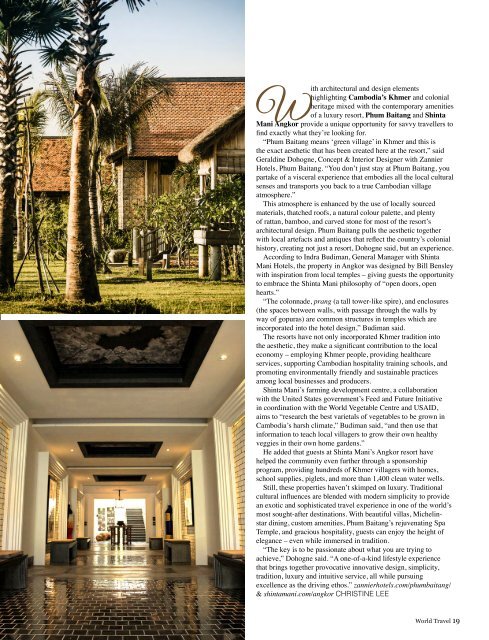2017 04 Aug Sept
Create successful ePaper yourself
Turn your PDF publications into a flip-book with our unique Google optimized e-Paper software.
With architectural and design elements<br />
highlighting Cambodia’s Khmer and colonial<br />
heritage mixed with the contemporary amenities<br />
of a luxury resort, Phum Baitang and Shinta<br />
Mani Angkor provide a unique opportunity for savvy travellers to<br />
find exactly what they’re looking for.<br />
“Phum Baitang means ‘green village’ in Khmer and this is<br />
the exact aesthetic that has been created here at the resort,” said<br />
Geraldine Dohogne, Concept & Interior Designer with Zannier<br />
Hotels, Phum Baitang. “You don’t just stay at Phum Baitang, you<br />
partake of a visceral experience that embodies all the local cultural<br />
senses and transports you back to a true Cambodian village<br />
atmosphere.”<br />
This atmosphere is enhanced by the use of locally sourced<br />
materials, thatched roofs, a natural colour palette, and plenty<br />
of rattan, bamboo, and carved stone for most of the resort’s<br />
architectural design. Phum Baitang pulls the aesthetic together<br />
with local artefacts and antiques that reflect the country’s colonial<br />
history, creating not just a resort, Dohogne said, but an experience.<br />
According to Indra Budiman, General Manager with Shinta<br />
Mani Hotels, the property in Angkor was designed by Bill Bensley<br />
with inspiration from local temples – giving guests the opportunity<br />
to embrace the Shinta Mani philosophy of “open doors, open<br />
hearts.”<br />
“The colonnade, prang (a tall tower-like spire), and enclosures<br />
(the spaces between walls, with passage through the walls by<br />
way of gopuras) are common structures in temples which are<br />
incorporated into the hotel design,” Budiman said.<br />
The resorts have not only incorporated Khmer tradition into<br />
the aesthetic, they make a significant contribution to the local<br />
economy – employing Khmer people, providing healthcare<br />
services, supporting Cambodian hospitality training schools, and<br />
promoting environmentally friendly and sustainable practices<br />
among local businesses and producers.<br />
Shinta Mani’s farming development centre, a collaboration<br />
with the United States government’s Feed and Future Initiative<br />
in coordination with the World Vegetable Centre and USAID,<br />
aims to “research the best varietals of vegetables to be grown in<br />
Cambodia’s harsh climate,” Budiman said, “and then use that<br />
information to teach local villagers to grow their own healthy<br />
veggies in their own home gardens.”<br />
He added that guests at Shinta Mani’s Angkor resort have<br />
helped the community even further through a sponsorship<br />
program, providing hundreds of Khmer villagers with homes,<br />
school supplies, piglets, and more than 1,400 clean water wells.<br />
Still, these properties haven’t skimped on luxury. Traditional<br />
cultural influences are blended with modern simplicity to provide<br />
an exotic and sophisticated travel experience in one of the world’s<br />
most sought-after destinations. With beautiful villas, Michelinstar<br />
dining, custom amenities, Phum Baitang’s rejuvenating Spa<br />
Temple, and gracious hospitality, guests can enjoy the height of<br />
elegance – even while immersed in tradition.<br />
“The key is to be passionate about what you are trying to<br />
achieve,” Dohogne said. “A one-of-a-kind lifestyle experience<br />
that brings together provocative innovative design, simplicity,<br />
tradition, luxury and intuitive service, all while pursuing<br />
excellence as the driving ethos.” zannierhotels.com/phumbaitang/<br />
& shintamani.com/angkor CHRISTINE LEE<br />
World Travel 19


